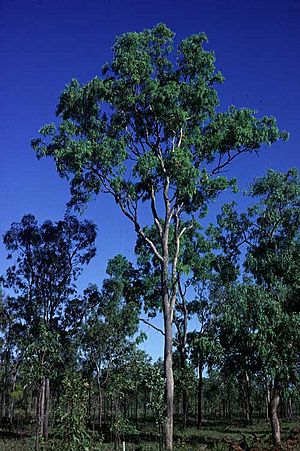Molloy red box facts for kids
Quick facts for kids Molloy red box |
|
|---|---|
 |
|
| Scientific classification | |
| Genus: |
Eucalyptus
|
| Species: |
leptophleba
|
| Synonyms | |
|
|
The Molloy red box (scientific name: Eucalyptus leptophleba) is a special type of tree. It is also known as the Molloy box. This tree is found only in Queensland, Australia. It has rough bark on its trunk and branches. Its leaves are shaped like a spear or are slightly curved. The tree produces white flowers and fruit that look like cups or barrels.
Contents
What the Molloy Red Box Looks Like
The Molloy red box is a tree that usually grows to be about 14 to 28 meters (46 to 92 feet) tall. It has a special woody swelling at its base called a lignotuber. This helps the tree regrow if it gets damaged.
Bark and Leaves
The bark on the trunk and smaller branches is grey and rough. It has many small cracks, like a "box" type bark. Young plants and new shoots (called coppice) have leaves that are egg-shaped or broadly spear-shaped. These leaves are about 45 to 130 millimeters (1.8 to 5.1 inches) long and 25 to 28 millimeters (1.0 to 1.1 inches) wide. They have a stalk called a petiole.
Adult leaves grow in an alternating pattern along the branches. They are narrow and spear-shaped, or sometimes curved. These leaves are 10 to 250 millimeters (0.4 to 9.8 inches) long and 12 to 40 millimeters (0.5 to 1.6 inches) wide. Their petiole is 13 to 33 millimeters (0.5 to 1.3 inches) long. Both sides of the adult leaves are a dull green to blue-green color, and they have a pointed tip.
Flowers and Fruit
The flower buds grow at the ends of the small branches. They are usually found in groups of seven, but sometimes three. These groups are on a branching stalk called a peduncle, which is 5 to 15 millimeters (0.2 to 0.6 inches) long. Each individual flower has its own small stalk, called a pedicel, which is 2 to 8 millimeters (0.1 to 0.3 inches) long.
Mature buds are oval-shaped, about 7 to 11 millimeters (0.3 to 0.4 inches) long and 4 to 6 millimeters (0.2 to 0.2 inches) wide. They have a cone-shaped or rounded cap called an operculum. The Molloy red box blooms between January and June, producing white flowers.
The fruit is a woody capsule that looks like a cup or a barrel. It is 6 to 10 millimeters (0.2 to 0.4 inches) long and 5 to 11 millimeters (0.2 to 0.4 inches) wide. The parts that open to release the seeds (called valves) are usually level with the rim of the fruit or stick out a little. The seeds inside are dark brown, flattened ovals, and about 2 to 3.5 millimeters (0.08 to 0.14 inches) long.
How the Molloy Red Box Got Its Name
The Molloy red box was first officially described in 1859 by a botanist named Ferdinand von Mueller. He published his description in a scientific journal called Journal of the Proceedings of the Linnean Society, Botany.
The scientific name leptophleba comes from two Greek words. Leptos means "fine," "small," or "thin," and phlebos means "vein." This name refers to the thin veins you can see on the tree's leaves.
Where the Molloy Red Box Lives
The Molloy red box is found only in certain parts of northern Queensland, Australia. You can find it from the Hughenden and Croydon areas in the south. It also grows in the drier western part of the Atherton Tablelands.
This tree is also present on the eastern side of the Cape York Peninsula, including Thursday Island in the Torres Strait. Some smaller groups of these trees are found on the western side of the Cape York Peninsula, near Weipa and northwest of Mungana.
Conservation Status
The Queensland Government has classified this type of eucalypt as "least concern" under its Nature Conservation Act 1992. This means that the Molloy red box is not currently considered to be at risk of disappearing.

